Three-Phase Induction Motors Online Protection against Unbalanced Supply Voltages
Abstract
:1. Introduction
2. The Proposed USV Detection Method
3. Experimental Validation
3.1. Sensitivity to the Occurrence of Low USV
3.2. Sensitivity to the USV’s Severity
3.3. Robustness against Load Variations
3.4. Robustness against Similar Faults
- (1)
- Start the motor in a healthy state, with balanced supply voltages, at no load;
- (2)
- Increase the motor load by 20% (the motor always in healthy state);
- (3)
- Introduce an ITSCF of 18 turns in the phase “a”, under 20% of load, with balanced supply voltages;
- (4)
- Increase the motor load to 40% (the motor remains with ITSCF and balanced supply voltages);
- (5)
- Introduce an USV of 1.8% in the presence of ITSCF.
4. Conclusions
Author Contributions
Funding
Data Availability Statement
Conflicts of Interest
References
- Cummings, P.B.; Dunki-Jacobs, J.R.; Kerr, R.H. Protection of induction motors against unbalanced voltage operation. IEEE Trans. Ind. Appl. 1985, IA-21, 778–792. [Google Scholar] [CrossRef]
- Bento, F.J.F.; Adouni, A.; Muxiri, A.C.P.; Fonseca, D.S.B.; Cardoso, A.J.M. On the Risk of Failure to Prevent Induction Motors Permanent Damage, Due to the Short Available Time-to-Diagnosis of Inter-Turn Short-Circuit Faults. IET Electr. Power Appl. 2021, 15, 51–62. [Google Scholar] [CrossRef]
- Adouni, A.; Marques Cardoso, J.A. Thermal Analysis of Low-Power Three-Phase Induction Motors Operating under Voltage Unbalance and Inter-Turn Short Circuit Faults. Machines 2021, 9, 2. [Google Scholar] [CrossRef]
- Kurt, M.S.; Balci, M.E.; Aleem, S.H.E.A. Algorithm for estimating derating of induction motors supplied with under/over unbalanced voltages using response surface methodology. J. Eng. 2017, 2017, 627–633. [Google Scholar] [CrossRef]
- Motors and Generators, NEMA MG1. 2014. Available online: https://www.techstreet.com/standards/nema-mg-1-2014?product_id=1888468 (accessed on 23 August 2021).
- Smith, J.C.; Hensley, G.; Ray, L. 1159-1995-IEEE Recommended Practice for Monitoring Electric Power Quality; IEEE: New York, NY, USA, 1995; Available online: https://ieeexplore.ieee.org/document/8796486 (accessed on 23 August 2021).
- IEEE Standard. IEEE Recommended Practice for Monitoring Electric Power Quality; IEEE Std, ICS Code: 29.240.01—Power Transmission and Distribution Networks in General; IEEE Standard: New York, NY, USA, 2012; pp. 1159–2009. [Google Scholar]
- Machines—Part Rotating Electrical. 26: Effects of Unbalanced Voltages on the Performance of Three-Phase Induction Motors. IEC 2002, 60, 26–34.
- Lashkari, N.; Poshtan, J.; Azgomi, H.F. Simulative and experimental investigation on stator winding turn and unbalanced supply voltage fault diagnosis in induction motors using artificial neural networks. ISA Trans. 2015, 59, 334–342. [Google Scholar] [CrossRef] [PubMed]
- Fortescue, C.L. Method of symmetrical co-ordinates applied to the solution of polyphase networks. Trans. Am. Inst. Electr. Eng. 1918, 37, 1027–1140. [Google Scholar] [CrossRef]
- IEC 60034-1. Rotating Electrical Machines Part 1: Rating and Performance; International Electrotechnical Commission (IEC): Geneva, Switzerland, 2004. [Google Scholar]
- Wang, Y.J. Analysis of effects of three-phase voltage unbalance on induction motors with emphasis on the angle of the complex voltage unbalance factor. IEEE Trans. Energy Convers. 2001, 16, 270–275. [Google Scholar] [CrossRef]
- Faiz, J.; Ebrahimpour, H.; Pillay, P. Influence of unbalanced voltage on the steady-state performance of a three-phase squirrel-cage induction motor. IEEE Trans. Energy Convers. 2004, 19, 657–662. [Google Scholar] [CrossRef]
- Mantilla, L.F. An analytical and graphical study of the symmetrical components in an induction motor supply in relation to the voltage unbalance parameters. Electr. Eng. 2007, 89, 535–545. [Google Scholar] [CrossRef]
- Anwari, M.; Hiendro, A. New unbalance factor for estimating performance of a three-phase induction motor with under-and overvoltage unbalance. IEEE Trans. Energy Convers. 2010, 25, 619–625. [Google Scholar] [CrossRef]
- Rengifo, J.; Salazar, H.; Bueno, A.; Aller, J.M. Experimental evaluation of the voltage unbalance in the efficiency of induction motors. In Proceedings of the 2017 IEEE Workshop on Power Electronics and Power Quality Applications (PEPQA), Bogota, Colombia, 31 May–2 June 2017; pp. 1–6. [Google Scholar]
- Tabora, J.M.; Tostes, M.E.D.L.; de Matos, E.O.; Bezerra, U.H.; Soares, T.M.; de Albuquerque, B.S. Assessing Voltage Unbalance Conditions in IE2, IE3 and IE4 Classes Induction Motors. IEEE Access 2020, 8, 186725–186739. [Google Scholar] [CrossRef]
- Dekhandji, F.Z.; Refoufi, L.; Bentarzi, H. Quantitative assessment of three phase supply voltage unbalance effects on induction motors. Int. J. Syst. Assur. Eng. Manag. 2017, 8, 393–406. [Google Scholar] [CrossRef]
- Agamloh, E.B.; Peele, S.; Grappe, J. Operation of variable frequency drive motor systems with source voltage unbalance. In Proceedings of the 2017 Annual Pulp, Paper and Forest Industries Technical Conference (PPFIC), Tacoma, WA, USA, 18–23 June 2017; pp. 1–9. [Google Scholar]
- Moussa, M.A.; Maouche, Y.; Louze, L.; Khezzar, A. A practical implementation of online computational tool for unbalanced voltage supply detection in induction motor. In Proceedings of the 2014 IEEE International Conference on Power and Energy (PECon), Kuching, Malaysia, 1–3 December 2014; pp. 93–98. [Google Scholar]
- Samsi, R.; Ray, A.; Mayer, J. Early detection of stator voltage imbalance in three-phase induction motors. Electr. Power Syst. Res. 2009, 79, 239–245. [Google Scholar] [CrossRef]
- Corres, J.M.; Bravo, J.; Arregui, F.J.; Matias, I.R. Unbalance and harmonics detection in induction motors using an optical fiber sensor. IEEE Sens. J. 2006, 6, 605–612. [Google Scholar] [CrossRef]
- Gonzalez-Cordoba, J.L.; Osornio-Rios, R.A.; Granados-Lieberman, D.; Romero-Troncoso, R.D.; Valtierra-Rodriguez, M. Thermal-impact-based protection of induction motors under voltage unbalance conditions. IEEE Trans. Energy Convers. 2018, 334, 1748–1756. [Google Scholar] [CrossRef]
- Sahraoui, M.; Cardoso, A.J.M.; Ghoggal, A. The use of a modified prony method to track the broken rotor bar characteristic frequencies and amplitudes in three-phase induction motors. IEEE Trans. Ind. Appl. 2014, 51, 2136–2147. [Google Scholar] [CrossRef]
- Yahia, K.; Sahraoui, M.; Cardoso, A.J.M.; Ghoggal, A. The use of a modified Prony’s method to detect the airgap-eccentricity occurrence in induction motors. IEEE Trans. Ind. Appl. 2016, 52, 3869–3877. [Google Scholar] [CrossRef]
- Shigenobu, R.; Nakadomari, A.; Hong, Y.-Y.; Mandal, P.; Takahashi, H.; Senjyu, T. Optimization of Voltage Unbalance Compensation by Smart Inverter. Energies 2020, 13, 4623. [Google Scholar] [CrossRef]
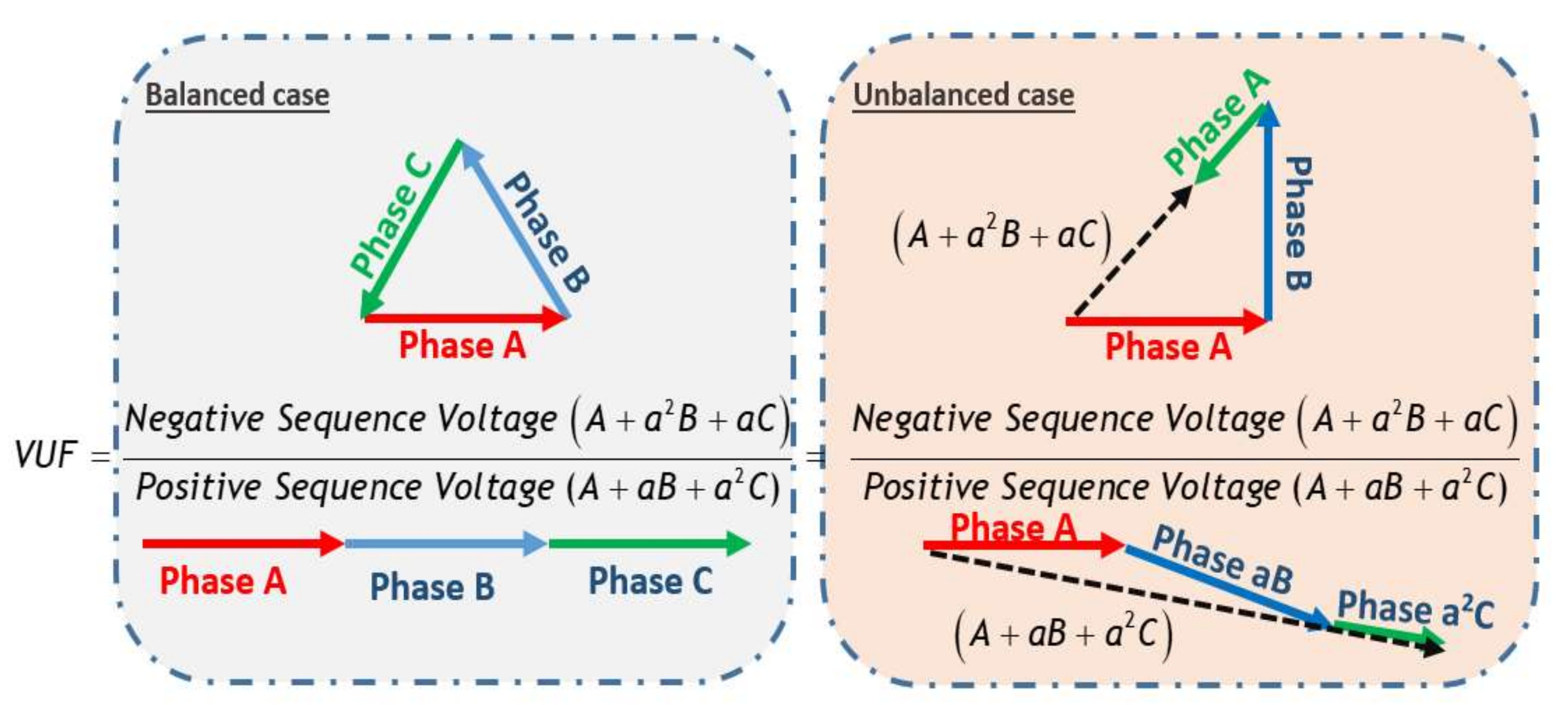

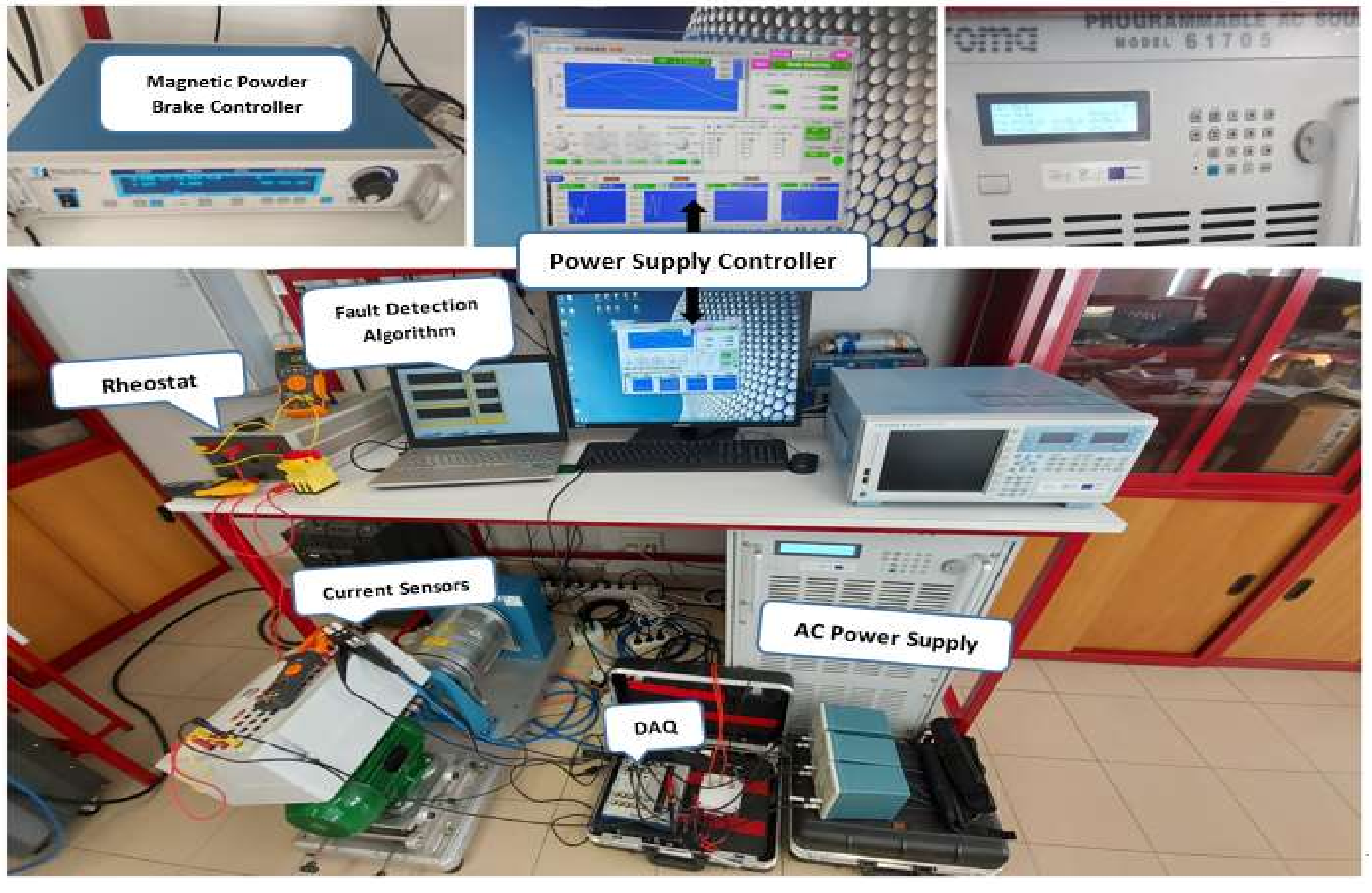
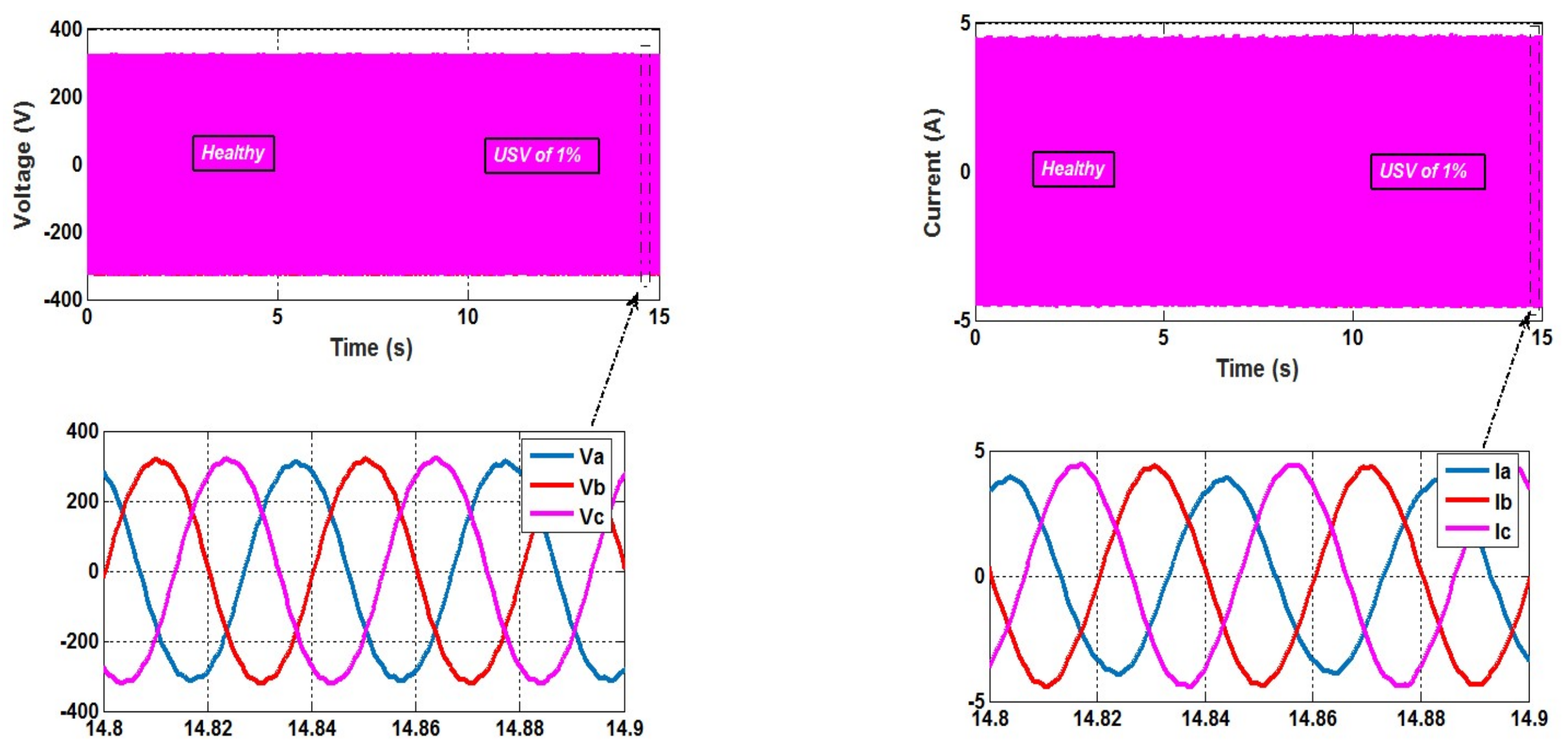
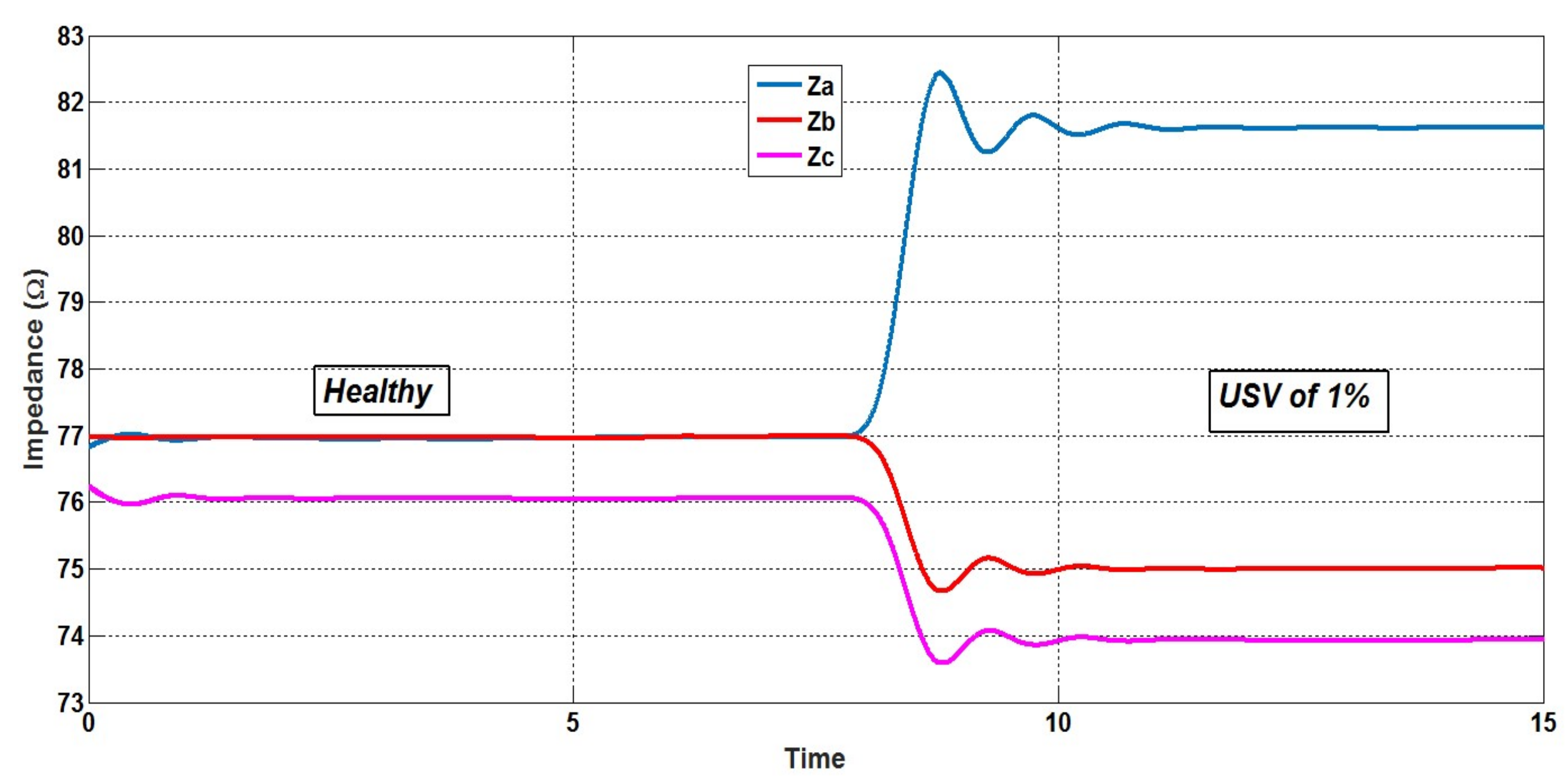
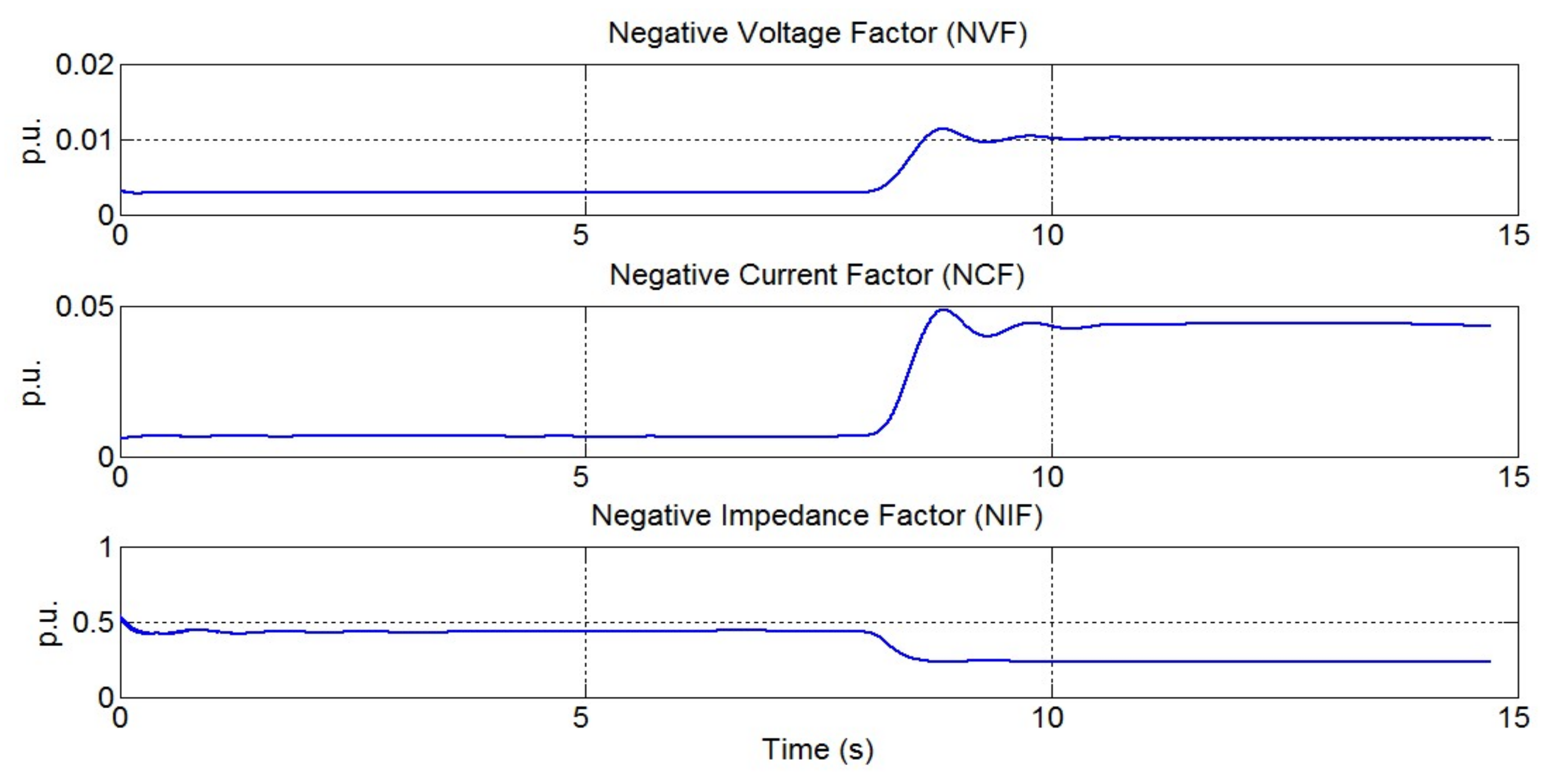
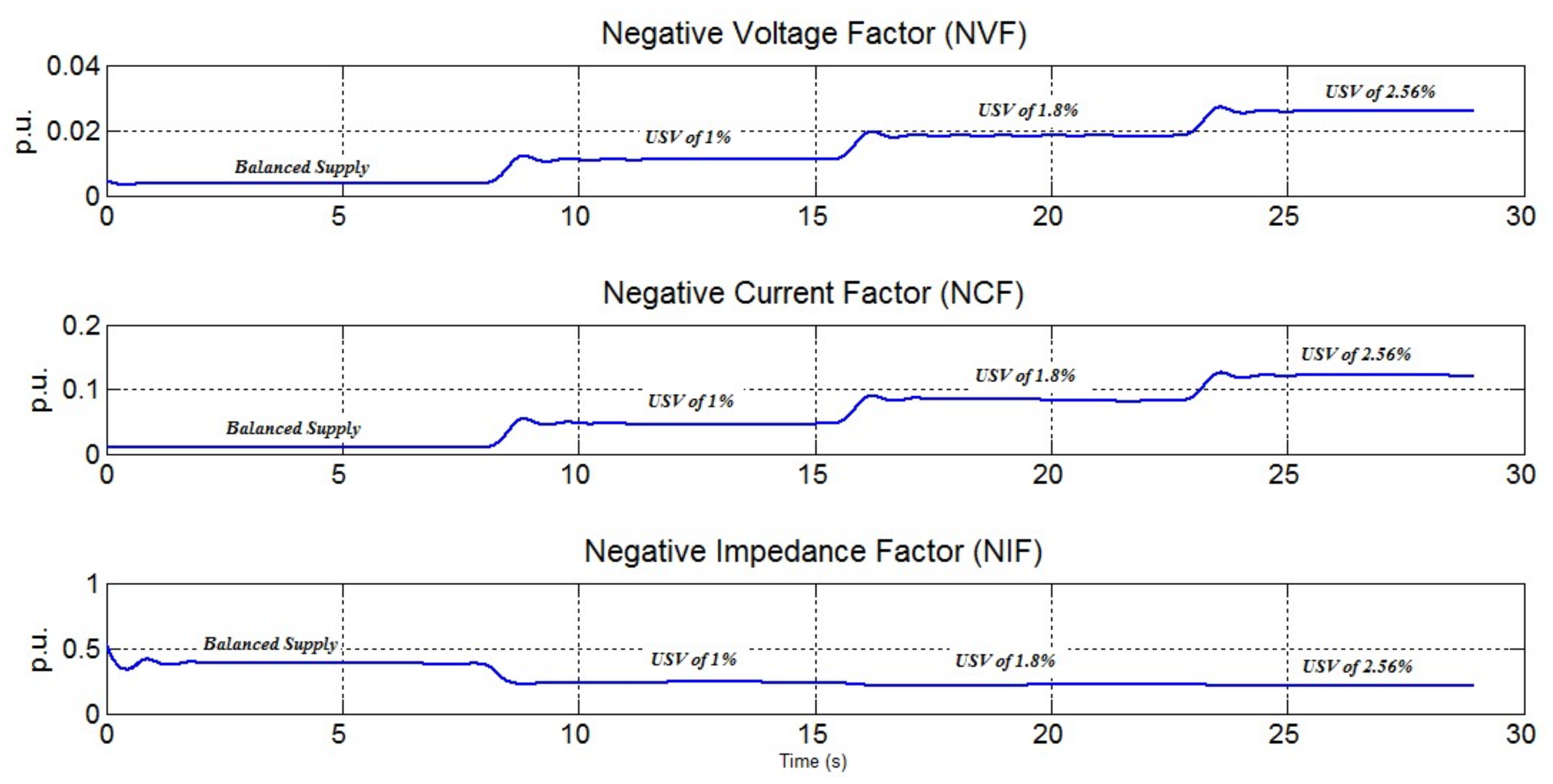
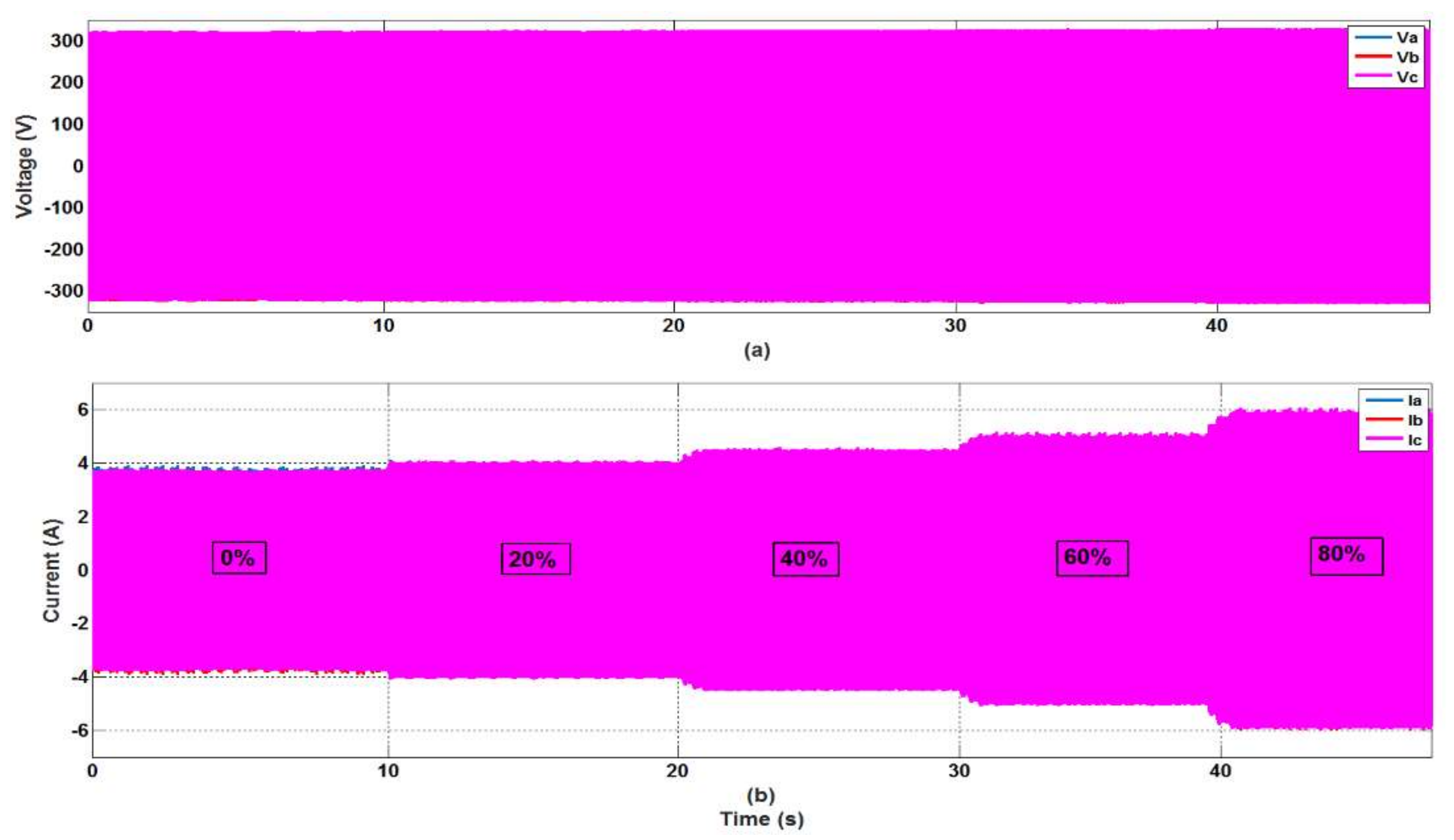
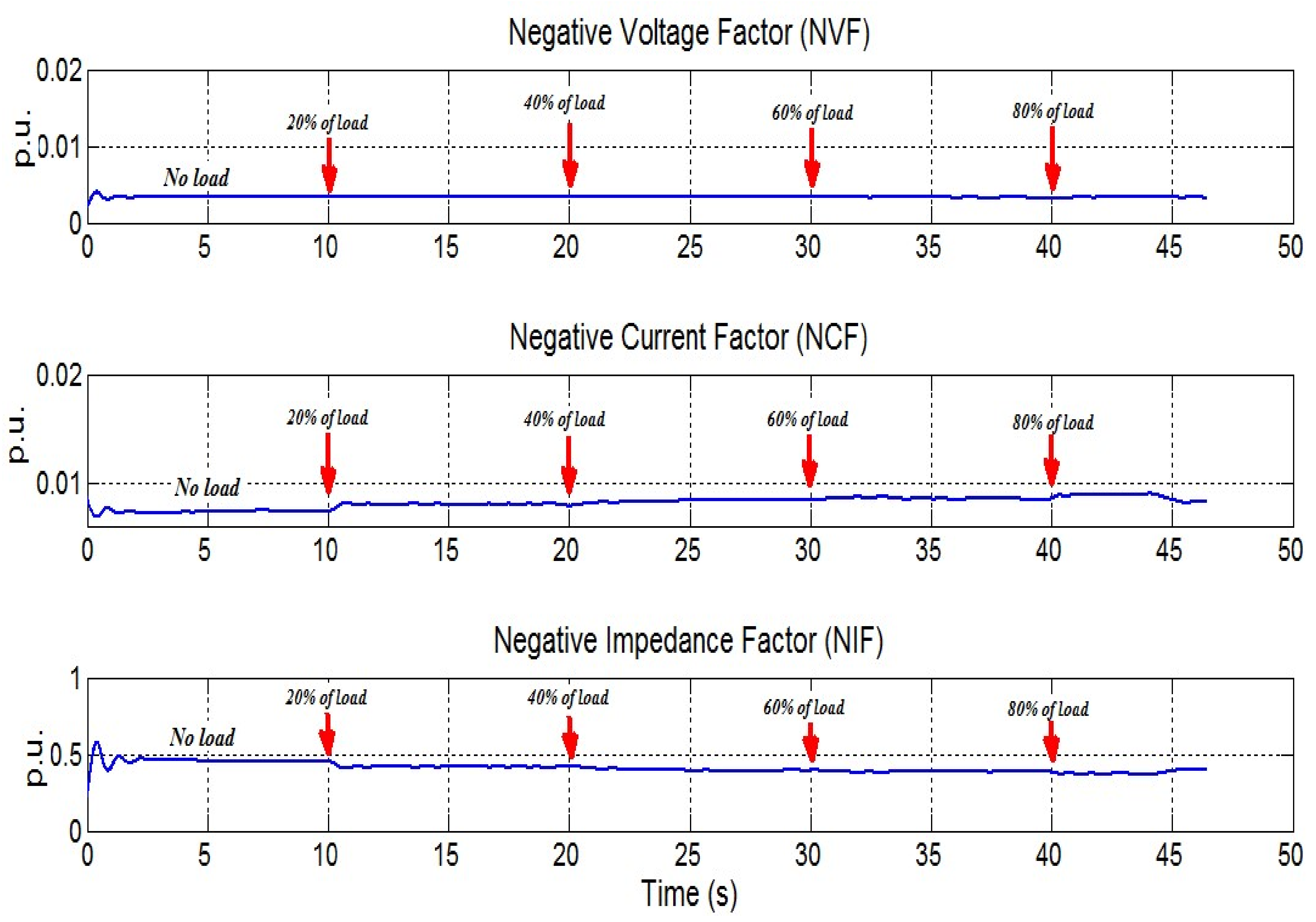
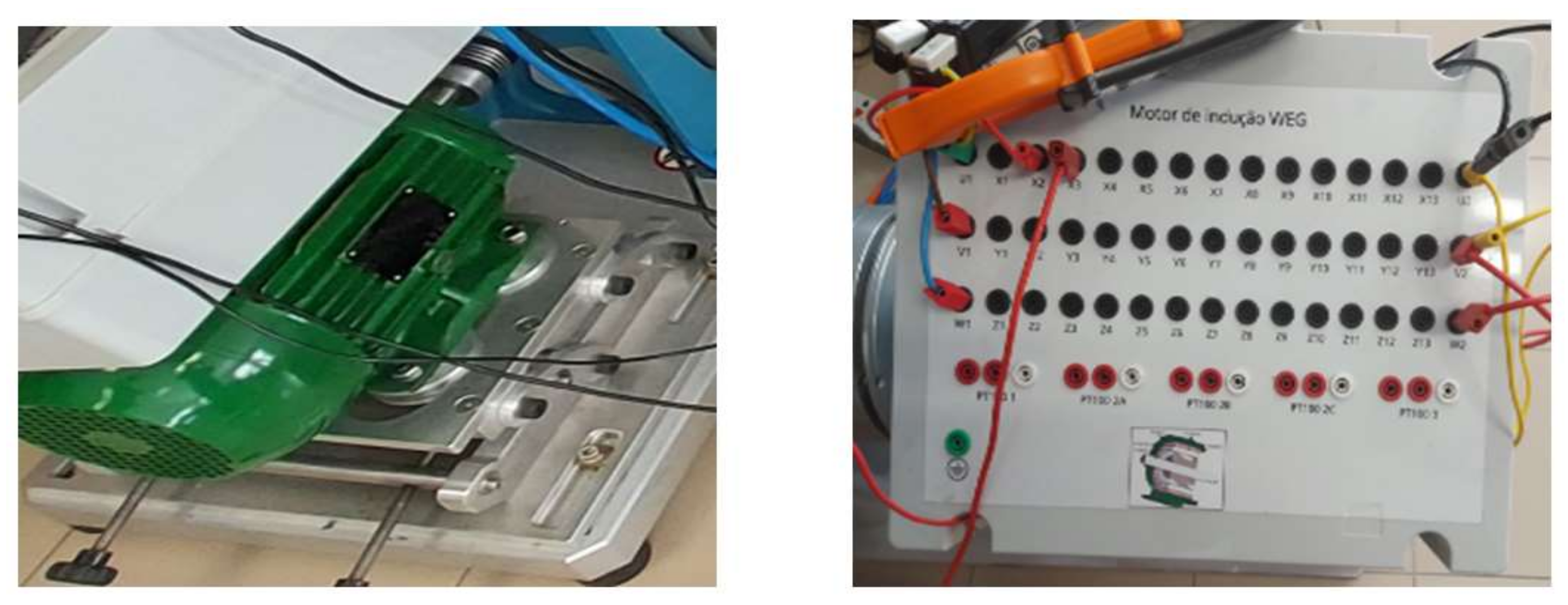
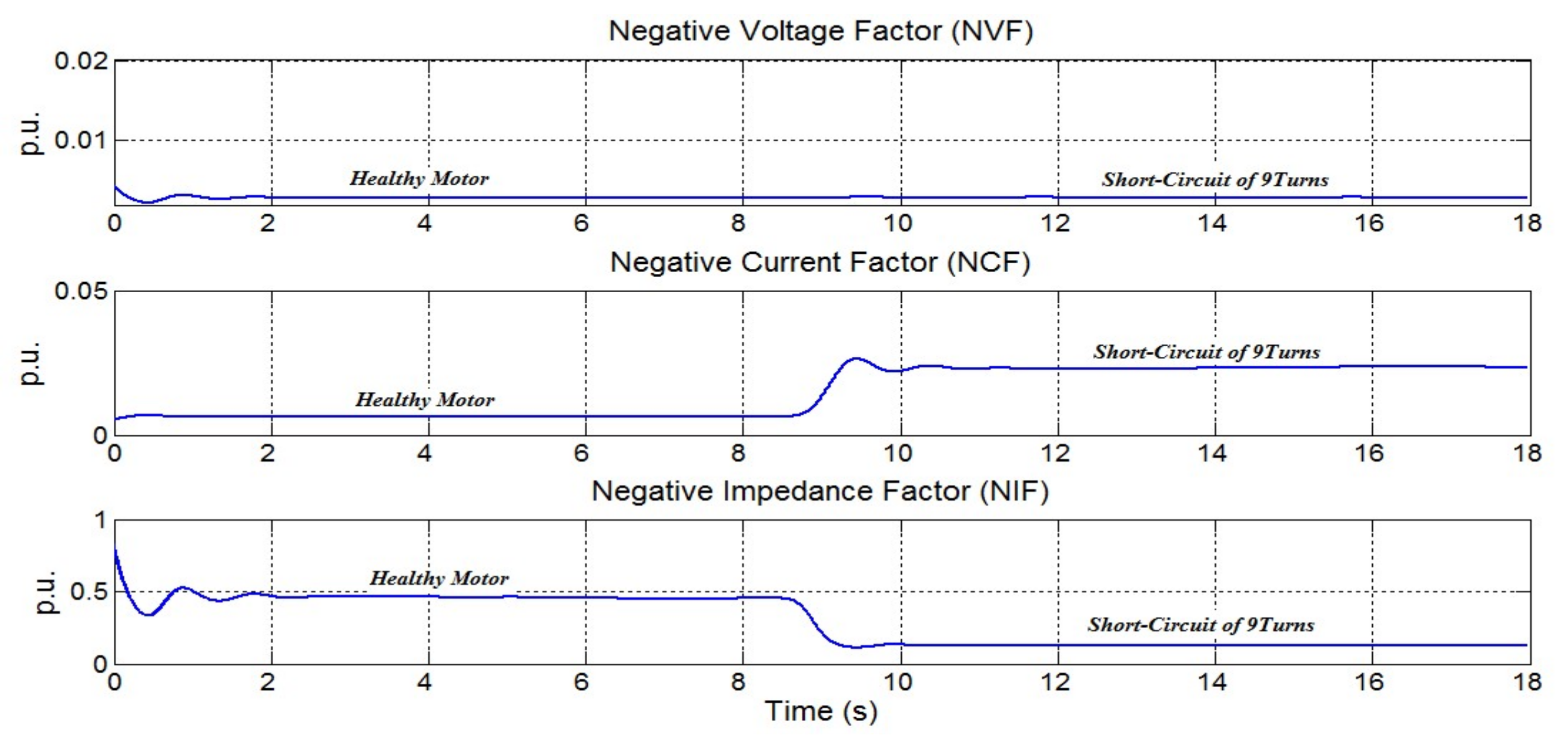
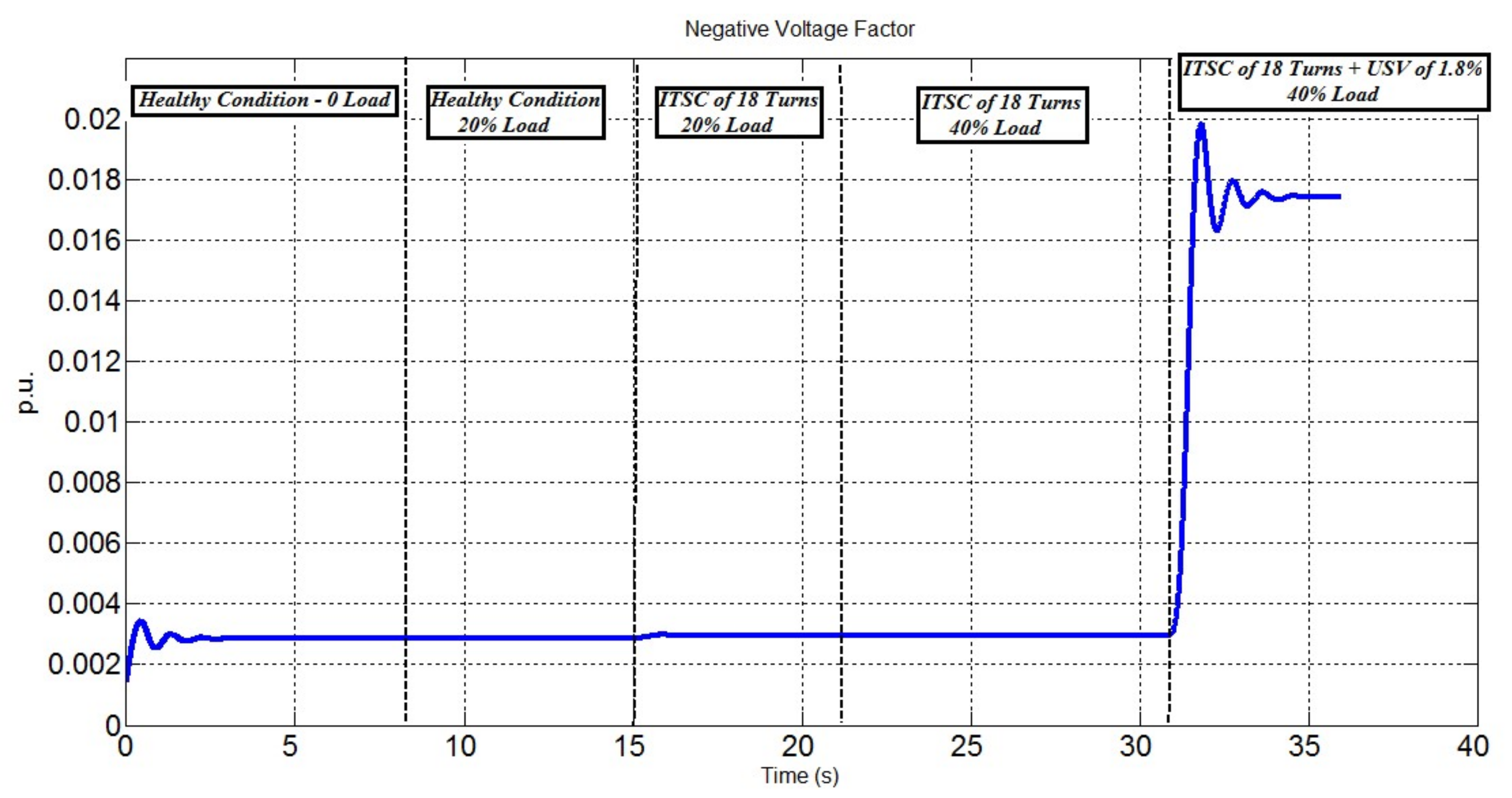
| General | Power [kW] | 2.2 |
| Speed [r/min] | 1435 | |
| Frequency [Hz] | 50 | |
| Torque [N·m] | 14.6 | |
| Voltage [V] | 400, Star Connection | |
| Current [A] | 4.56, Star Connection | |
| Number of Poles | 4 | |
| Cooling | Closed Motor with external ventilation-IC 411 |
| n = 100 Samples | Unbalance Supply Voltage Severity (%) | ||
|---|---|---|---|
| Unbalance Factors | 0% | 1% | Rate of Variation (%) |
| NVF | 0.002863 | 0.0101 | +252% |
| NCF | 0.006534 | 0.04419 | +576% |
| NIF | 0.4343 | 0.2292 | −47.22% |
| Monitoring Factors | Factor’s Magnitudes for Balanced Voltages (p.u.) | Rate of Variations for Different Severities of USV | ||
|---|---|---|---|---|
| USV of 1% | USV of 1.8% | USV of 2.56% | ||
| NVF | 0.003632 | +200% | +402% | +608% |
| NCF | 0.009469 | +377% | +786% | +1190% |
| NIF | 0.3834 | −37.8% | −43.9% | −45% |
| Inter-Turn Short-Circuit Fault | |||
|---|---|---|---|
| Unbalance Factors | Healthy | 9 Turns | Rate of Variation (%) |
| NVF | 0.00288 | 0.002929 | +3.5% |
| NCF | 0.00654 | 0.02324 | +255% |
| NIF | 0.445 | 0.1276 | −71.3% |
Publisher’s Note: MDPI stays neutral with regard to jurisdictional claims in published maps and institutional affiliations. |
© 2021 by the authors. Licensee MDPI, Basel, Switzerland. This article is an open access article distributed under the terms and conditions of the Creative Commons Attribution (CC BY) license (https://creativecommons.org/licenses/by/4.0/).
Share and Cite
Laadjal, K.; Sahraoui, M.; Alloui, A.; Cardoso, A.J.M. Three-Phase Induction Motors Online Protection against Unbalanced Supply Voltages. Machines 2021, 9, 203. https://doi.org/10.3390/machines9090203
Laadjal K, Sahraoui M, Alloui A, Cardoso AJM. Three-Phase Induction Motors Online Protection against Unbalanced Supply Voltages. Machines. 2021; 9(9):203. https://doi.org/10.3390/machines9090203
Chicago/Turabian StyleLaadjal, Khaled, Mohamed Sahraoui, Abdeldjalil Alloui, and Antonio J. Marques Cardoso. 2021. "Three-Phase Induction Motors Online Protection against Unbalanced Supply Voltages" Machines 9, no. 9: 203. https://doi.org/10.3390/machines9090203
APA StyleLaadjal, K., Sahraoui, M., Alloui, A., & Cardoso, A. J. M. (2021). Three-Phase Induction Motors Online Protection against Unbalanced Supply Voltages. Machines, 9(9), 203. https://doi.org/10.3390/machines9090203








